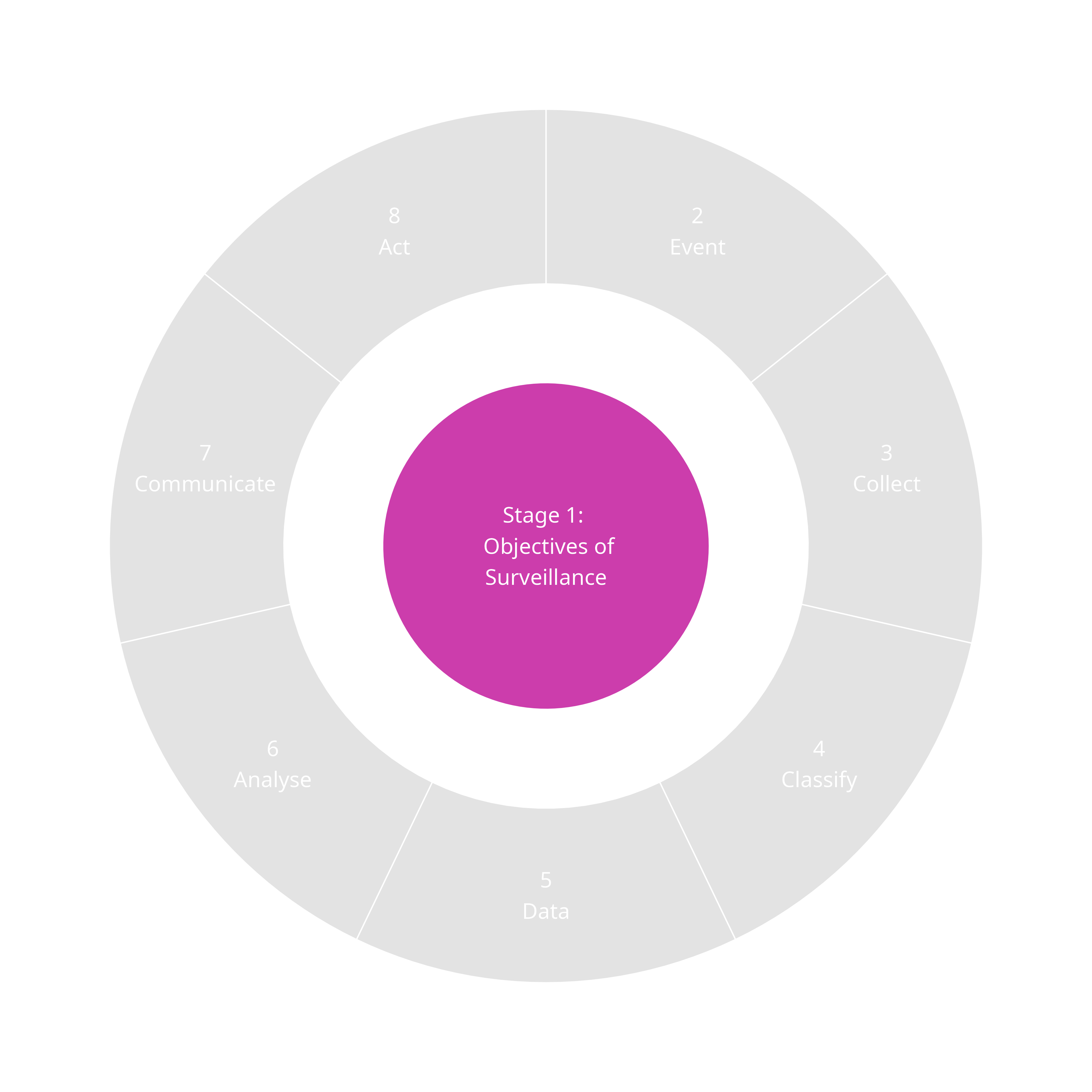
The objectives of a surveillance system are the reasons why a surveillance systems is set into place. The overall objective of infectious disease surveillance is described nicely in the German infection protection act:
prevent communicable diseases in humans, detect infections at an early stage, and stop their further spread
The overarching objectiv can be decomposed into more conrete objectives that are based on the interventions that can be taken. These can be subdivided into primary objectives that have a direct effect on the spread of an infectious disease or secondary objectives that exert and indirect influence.
Primary objectives
| Get information to initate case based action |
All the interventions that are taken when there is a person with an infection |
| Get information to initate population based action |
All the interventions that are taken that affect a large part of the population |
| Get information to initate individual action |
interventions taken by the individual |
| Get information to initate action by medical professionals |
The interventions that are taken by the medical system. A special form of the individual action |
Secondary objectives
| Scientific advances |
Advance the knowledge on infectious diseases |
| Evaluation |
Documents the impact of an intervention, or track progress towards specified goals |
| Resource allocation |
Set priorities by the governmant or an institution and develope long term strategy |
| Fullfill obligation |
Most nations have commited themselves to the International Health regulations. Thus they have to set up surveillance system |
Scientific advances
Surveillance systems collect data that can also be used for public health research. Scientists can use the data to analyse specific public health problems. The system can give information about the nature of a pathogen and epidemiological characteristics of a public health problem. One example would be the change of variants that follow the introduction of a new vaccine.
Evaluation
Public health interventions should be benefical for the population. The intervention can measure output, outcome and impact. Measuring the impact can be considered the most important part because it shows the benefits. This impact measurement can be done in with a surveillance system.
Resource allocation
Governments need to decide about their priorities and the distribution of resources. These decisions can be taken upon the information from surveillance systems.
Fullfill obligation
The International health regulations require: Each State Party shall develop, strengthen and maintain […] the capacity to detect, assess, notify and report events Thus it can be an objective of a surveillance system to fullfill these obligations.
Other concepts for objectives
There are other summaries for the objectives of a surveillance system that have a similar concepts. Although they tend to be not specific but have a broader perspective.
World bank
The world bank notes the objectives of an public health surveillance system as follows:
- recognize cases or clusters of cases to trigger interventions to prevent transmission or reduce morbidity and mortality (includes the special case in which surveillance at the national level is required to recognize multi-state clusters);
- identify new health problems and emerging diseases;
- assess public health impact of health events or determine and measure trends;
- measure causal factors in disease (e.g., risk factors) to initiate actions to prevent the onset of disease;
- demonstrate the need for intervention programs and resources, and allocate resources during health planning;
- monitor effectiveness and evaluate the impact of prevention and control measures, intervention strategies, and health policy changes;
- identify high-risk population groups or geographic areas to target interventions and guide analytic studies;
- provide data for research, and develop hypotheses that lead to analytic studies about risk factors for disease causation, propagation or progression;
- measure progress toward Millennium Development Goals, or other project or program goals, including PRSP (Poverty Reduction Strategy Paper) targets._
EU/EEA surveillance
The EU/EEA surveillance focuses on the need for the supranational body
- Detect and monitor any multinational infectious disease outbreaks with respect to source, time, population, and place in order to provide a rationale for public health action;
- Monitor trends in infectious diseases over time and across Member States to assess the present situation, respond to rises above warning thresholds and facilitate appropriate evidence-based action;
- Contribute to the evaluation and monitoring of prevention and control programmes targeted at infectious diseases in order to provide the evidence for recommendations to strengthen and improve these programmes at the national and European level;
- Identify population groups at risk and in need of targeted prevention measures;
- Contribute to the awareness of and the assessment of the burden of infectious diseases on the population using such data as disease prevalence, complications, hospitalisation, and mortality; and
- Generate hypotheses on (new) sources, modes of transmission and groups most at risk and identify needs for research and pilot projects
Objectives in practice
Although objectives play a decisive role in theory they are not as relevant in practice. Large surveillance systems tend to develope a life on its own and the focus on the objectives gets lost over time. New changes are introduced based on new needs but old parts stay in place although they might have losts their importance. Furthermore we a entagled into a complicated net of the large surveillancesystems and a single person is rarely in the position to change a complete system. So to really set the focus on the objectives is a difficult undertaking.
When a surveillancesystem is changed there are often not purely rational and objective-based values at work. People tend to follow differen decision making processes than a rational approach. Besides a rational approach one can differ between a “standard-approach” an “environmental-approach” and a “garbage-can-apporach”.

